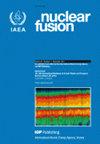具有饱和和多捕集效应的钨中氢保留和解吸的簇动力学模型
IF 4
1区 物理与天体物理
Q1 PHYSICS, FLUIDS & PLASMAS
引用次数: 0
摘要
钨(W)基等离子体面材料中氢(H)的保留和解吸仍未得到很好的理解,这主要是由于热解吸光谱(TDS)等实验检测方法的原位观测存在局限性。为了揭示 H 保留和解吸背后的基本机制,我们开发了一个群集动力学模型 IRadMat-TDS,用于对多晶 W 中氘(D)的深度分布和 TDS 进行理论建模。该模型新加入了 D 在晶界(GB)等固有汇中的饱和吸收和发射,以及 D 在各种类型 GB 中不同捕获能量的多重捕获效应。模拟的 TDS 光谱与实验光谱一致。对于在 keV 能量范围内接受 D 离子辐照的多晶 W,TDS 在 490 和 550 K 左右的两个典型热解吸峰分别明确归因于 GBs 和空位的 D 发射。而 GB 在 D 的保留中起着主要作用。此外,TDS 中的宽峰来自 D 在具有不同类型捕获位点的汇中的多捕获卷积,而不是单位点近似。本文章由计算机程序翻译,如有差异,请以英文原文为准。
Cluster dynamics modeling of hydrogen retention and desorption in tungsten with saturation and multi-trapping effect of sinks
Hydrogen (H) retention and desorption in tungsten (W)-based plasma-facing materials are still not well understood, largely due to the limitations of ex-situ observations in experimental detection methods like thermal desorption spectroscopy (TDS). In order to reveal the fundamental mechanisms behind H retention and desorption, we developed a cluster dynamics model, IRadMat-TDS, for theoretical modeling of depth distribution and TDS of deuterium (D) in polycrystalline W. The model newly includes the saturated absorption and emission of D in inherent sinks like grain boundaries (GBs), as well as the multi-trapping effect of D in various types of GBs with different trapping energies. The simulated TDS spectra are in agreement with experimental ones. For polycrystalline W under D ion irradiation within keV-energy range, two typical thermal desorption peaks in TDS at around 490 and 550 K are explicitly attributed to D emission from GBs and vacancies, respectively. And GBs play a major role in D retention. Moreover, the broad peaks in TDS come from the convolution of multi-trapping of D in sinks with different types of trapping sites rather than a single-site approximation.
求助全文
通过发布文献求助,成功后即可免费获取论文全文。
去求助
来源期刊

Nuclear Fusion
物理-物理:核物理
CiteScore
6.30
自引率
39.40%
发文量
411
审稿时长
2.6 months
期刊介绍:
Nuclear Fusion publishes articles making significant advances to the field of controlled thermonuclear fusion. The journal scope includes:
-the production, heating and confinement of high temperature plasmas;
-the physical properties of such plasmas;
-the experimental or theoretical methods of exploring or explaining them;
-fusion reactor physics;
-reactor concepts; and
-fusion technologies.
The journal has a dedicated Associate Editor for inertial confinement fusion.
 求助内容:
求助内容: 应助结果提醒方式:
应助结果提醒方式:


